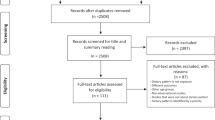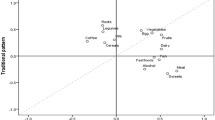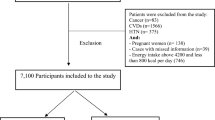Abstract
Background/Objectives:
To assess the possible role of particular patterns of food consumption in the occurrence of hypertension.
Subjects/Methods:
A cross-sectional study of 571 members of defence forces was carried out in eight military institutions in Yaounde, Cameroon. Blood pressure was measured with automatic sphygmomanometers simultaneously at both arms. Food consumption data were obtained through a food frequency questionnaire and lifestyle questionnaire was used to ascertain information on physical activity and other risk factors.
Results:
Two dietary patterns were identified. The ‘fruit and vegetable’ pattern was typified by a high intake of fruits, vegetables, tubers and legumes. The ‘meat’ pattern was characterized by a high intake of bush meat, poultry and red meat. After adjustment for age, body mass index, rank, vigorous physical activity and total energy intake, the fruit and vegetable pattern was significantly associated with a reduced risk of hypertension (odds ratio (OR)=0.40; 95% confidence interval (CI)=0.20–0.83, P=0.04) when comparing the highest to the lowest quartile of dietary pattern scores. No significant relationship was apparent between the meat pattern and hypertension.
Conclusions:
Our findings suggest that a diet rich in fruits, vegetables, tubers and legumes may have an important role in regulating blood pressure. More prospective and extensive data are warranted to investigate the magnitude of cardiovascular disease in that specific population.
This is a preview of subscription content, access via your institution
Access options
Subscribe to this journal
Receive 12 print issues and online access
$259.00 per year
only $21.58 per issue
Buy this article
- Purchase on Springer Link
- Instant access to full article PDF
Prices may be subject to local taxes which are calculated during checkout
Similar content being viewed by others
References
Ainsworth BE, Haskell WL, Whitt MC, Irwin ML, Swartz AM, Strath SJ et al. (2000). Compendium of physical activities: an update of activity codes and MET intensities. Med Sci Sports Exerc 32, S498–S504.
Appel LJ, Moore TJ, Obarzanek E, Vollmer WM, Svetkey LP, Sacks FM et al. (1997). A clinical trial of the effects of dietary patterns on blood pressure. DASH Collaborative Research Group. N Engl J Med 336, 1117–1124.
Armstrong B, van Merwyk AJ, Coates H (1977). Blood pressure in Seventh-day Adventist vegetarians. Am J Epidemiol 105, 444–449.
Arts IC, Hollman PC (2005). Polyphenols and disease risk in epidemiologic studies. Am J Clin Nutr 81, S317–S325.
Atsuko S, Akizumi T, Tadao G, Shizukiyo I, Toshiyuki O, Kazuomi K et al. (2008). Dietary patterns and levels of blood pressure and serum lipidsin a Japanese population. J Epidemiol 18, 58–67.
Chen Y, Factor-Litvak P, Howe GR, Parvez F, Ahsan H (2006). Nutritional influence on risk of high blood pressure in Bangladesh: a population-based cross-sectional study. Am J Clin Nutr 84, 1224–1232.
Chobanian AV, Bakris GL, Black HR, Cushman WC, Green LA, Izzo Jr JL et al. (2003). The seventh report of the joint national committee on prevention, detection, evaluation, and treatment of high blood pressure: the JNC 7 report. JAMA 289, 2560–2572.
Chockalingam A, Campbell NR, Fodor JG (2006). Worldwide epidemic of hypertension. Can J Cardiol 22, 553–555.
Ekoé JM, Zimmet P (2008). Diagnosis and classification. In : Ekoé JM, Rewers M, Williams R, Zimmet P (eds). The Epidemiology of Diabetes Mellitus second edition John Willey & Sons: Chichester, West Sussex, UK. pp 11–30.
Erdman Jr JW, Balentine D, Arab L, Beecher G, Dwyer JT, Folts J et al. (2005). Flavonoids and heart health: proceedings of the ILSI North America flavonoids workshop, May 31–June 1, 2005, Washington, DC. J Nutr 137, S718–S737.
Godwin M, Pike A, Kirby A, Jewer C, Murphy L (2008). Prehypertension and hypertension in a primary care practice. Can Fam Physician 54, 1418–1423.
Harlan WR, Harlan LC (1986). An epidemiological perspective on dietary electrolytes and hypertension. J Hypertens 4, S334–S339.
Harriss LR, English DR, Powles J, Giles GG, Tonkin AM, Hodge AM et al. (2007). Dietary patterns and cardiovascular mortality in the Melbourne collaborative cohort study. Am J Clin Nutr 86, 221–229.
He J, Gu D, Chen J, Wu X, Kelly TN, Huang JF et al. (2009). Premature deaths attributable to blood pressure in China: a prospective cohort study. Lancet 374, 1765–1772.
Hooper L, Kroon PA, Rimm EB, Cohn JS, Harvey I, Le Cornu KA et al. (2008). Flavonoids, flavonoid-rich foods, and cardiovascular risk: a meta-analysis of randomized controlled trials. Am J Clin Nutr 88, 38–50.
Kengne AP, Awah PK, Fezeu L, Mbanya JC (2007). The burden of high blood pressure and related risk factors in urban sub-Saharan Africa: evidences from Douala in Cameroon. Afr Health Sci 7, 38–44.
Kuczmarski RJ, Anderson JJ, Koch GG (1994). Correlates of blood pressure in Seventh-Day Adventist (SDA) and non-SDA adolescents. J Am Coll Nutr 13, 165–173.
Masala G, Bendinelli B, Versari D, Saieva C, Ceroti M, Santagiuliana F et al. (2008). Anthropometric and dietary determinants of blood pressure in over 7000 Mediterranean women: the European Prospective Investigation into Cancer and Nutrition-Florence cohort. J Hypertens 26, 2112–2120.
Metintas S, Arikan I, Kalyoncu C (2009). Awareness of hypertension and other cardiovascular risk factors in rural and urban areas in Turkey. Trans R Soc Trop Med Hyg 103, 812–818.
Mink PJ, Scrafford CG, Barraj LM, Harnack L, Hong CP, Nettleton JA et al. (2007). Flavonoid intake and cardiovascular disease mortality: a prospective study in postmenopausal women. Am J Clin Nutr 85, 895–909.
Miura K, Greenland P, Stamler J, Liu K, Daviglus ML, Nakagawa H (2004). Relation of vegetable, fruit, and meat intake to 7-year blood pressure change in middle-aged men: the Chicago Western Electric Study. Am J Epidemiol 159, 572–580.
Nuñez-Cordoba JM, Alonso A, Beunza JJ, Palma S, Gomez-Gracia E, Martinez-Gonzalez MA (2009). Role of vegetables and fruits in Mediterranean diets to prevent hypertension. Eur J Clin Nutr 63, 605–612.
O’Brien E (2001). State of the market for devices for blood pressure measurement. Blood Press Monit 6, 281–286.
Pereira M, Lunet N, Azevedo A, Barros H (2009). Differences in prevalence, awareness, treatment and control of hypertension between developing and developed countries. J Hypertens 27, 963–975.
Schulze MB, Hoffmann K, Kroke A, Boeing H (2001). Dietary patterns and their association with food and nutrient intake in the European prospective investigation into cancer and nutrition (EPIC)—Potsdam study. Br J Nutr 85, 363–373.
Touyz RM (2003). Reactive oxygen species in vascular biology: role in arterial hypertension. Expert Rev Cardiovasc Ther 1, 91–106.
Touyz RM, Schiffrin EL (2004). Reactive oxygen species in vascular biology: implications in hypertension. Histochem Cell Biol 122, 339–352.
Utsugi MT, Ohkubo T, Kikuya M, Kurimoto A, Sato RI, Suzuki K et al. (2008). Fruit and vegetable consumption and the risk of hypertension determined by self measurement of blood pressure at home: the Ohasama study. Hypertens Res 31, 1435–1443.
Wang L, Manson JE, Buring JE, Sesso HD (2008). Meat intake and the risk of hypertension in middle-aged and older women. J Hypertens 26, 215–222.
Wirfält E, Hedblad B, Gullberg B, Mattisson I, Andrén C, Rosander U et al. (2001). Food patterns and components of the metabolic syndrome in men and women: a cross-sectional study within the Malmö Diet and Cancer cohort. Am J Epidemiol 154, 1150–1159.
Yuchum L, Kushi LH, Meyer K, Folsom AR (1999). Dietary flavonoids intake and risk of cardiovascular disease in post menopausal women. Am J Epidemiol 149, 943–949.
Acknowledgements
This study was funded in part by the Cameroonian Minister Delegate at the Presidency, in Charge of Defence.
Author information
Authors and Affiliations
Corresponding author
Ethics declarations
Competing interests
The authors declare no conflict of interest.
Appendix
Rights and permissions
About this article
Cite this article
Nkondjock, A., Bizome, E. Dietary patterns associated with hypertension prevalence in the Cameroon defence forces. Eur J Clin Nutr 64, 1014–1021 (2010). https://doi.org/10.1038/ejcn.2010.109
Received:
Revised:
Accepted:
Published:
Issue Date:
DOI: https://doi.org/10.1038/ejcn.2010.109
Keywords
This article is cited by
-
Dietary patterns and their socioeconomic factors of adherence among adults in urban Burkina Faso: a cross-sectional study
Journal of Health, Population and Nutrition (2023)
-
Dietary patterns and associations with metabolic risk factors for non-communicable disease
Scientific Reports (2023)
-
The association between dietary patterns with severity of coronary artery stenosis, serum leptin-to-adiponectin ratio, and some related risk factors in patients with coronary artery disease
Journal of Diabetes & Metabolic Disorders (2021)
-
Dietary patterns interact with the variations of 18q21.23 rs17782313 locus on regulation of hypothalamic-pituitary axis hormones and cardio-metabolic risk factors in obesity
Eating and Weight Disorders - Studies on Anorexia, Bulimia and Obesity (2020)
-
Dietary Patterns, Smoking, and Cardiovascular Diseases: A Complex Association
Current Nutrition Reports (2013)



